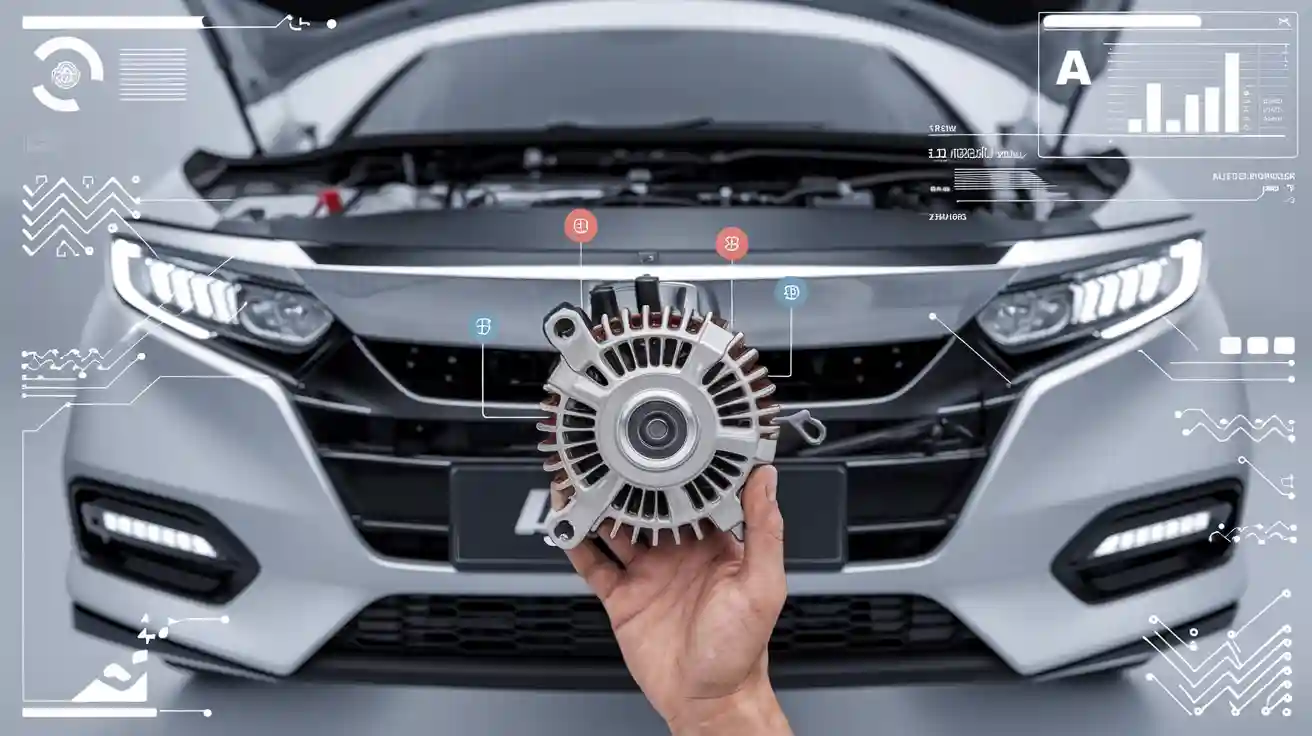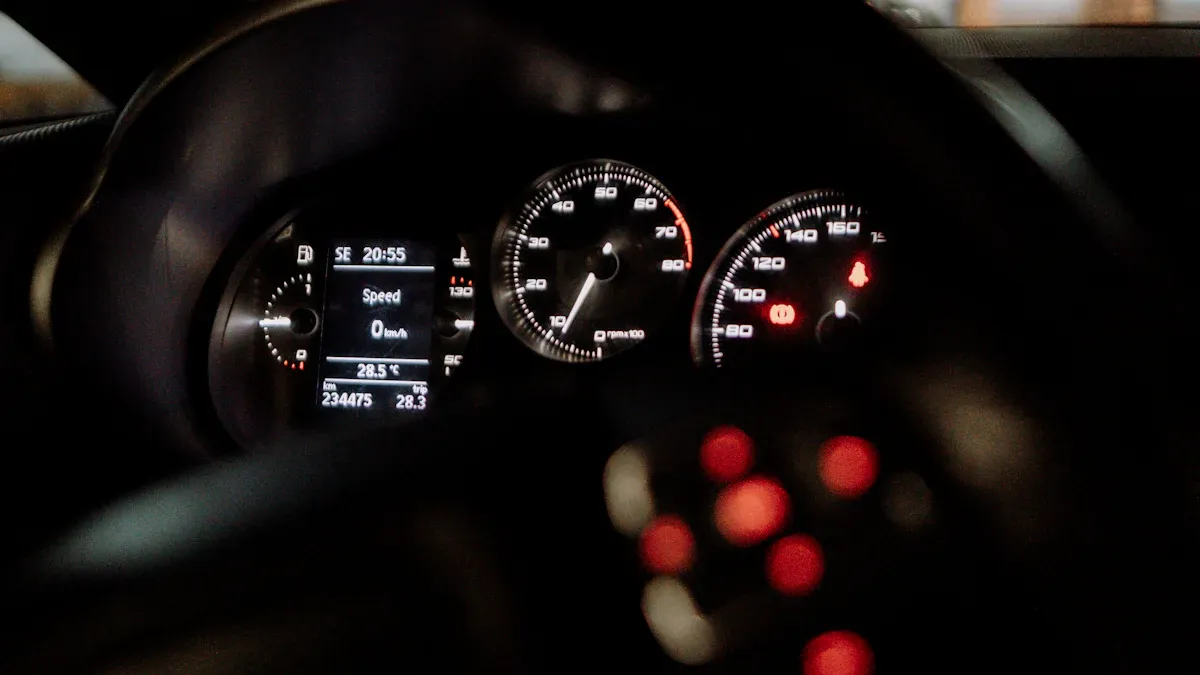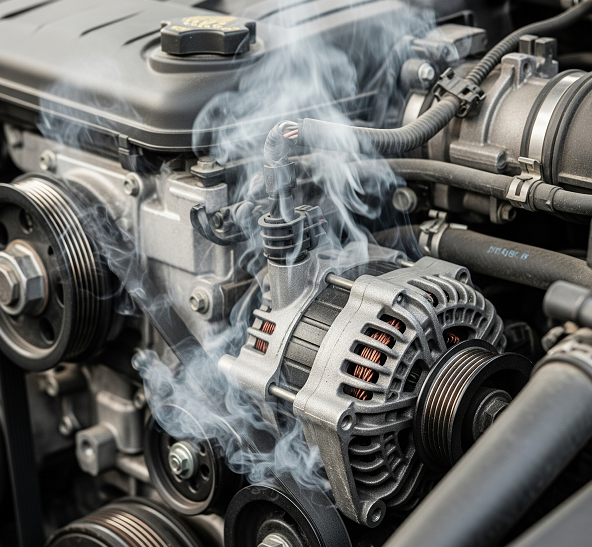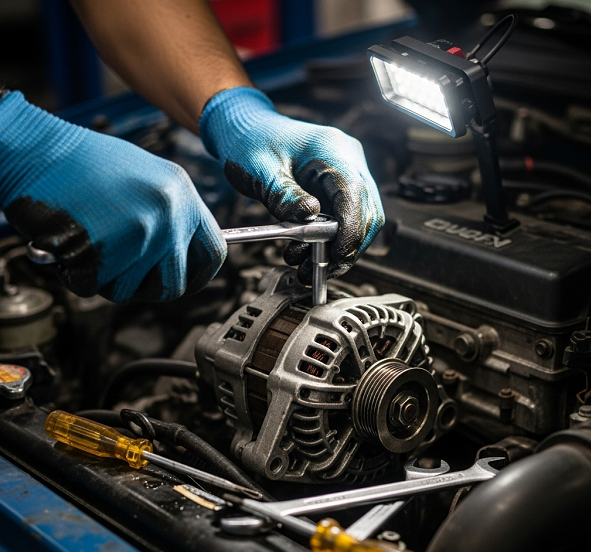
You might see three signs your Honda needs alternator repair. These are a battery warning light, dim or flickering headlights, and trouble with electrical accessories. If you notice these signs early, your car stays safe and works well. Finding problems early stops bigger issues. It helps you avoid surprise breakdowns and makes your car last longer. Honda service experts say quick repairs protect important systems like lights and sensors. Always pick an OEM Honda Alternator Supplier for the best fit and performance in your Honda.
Battery Warning Light
Signs Your Honda Needs an Alternator Repair
You might see the battery warning light on your dashboard. This light looks like a red or yellow battery icon. When it turns on, your car is warning you about the charging system. Sometimes, other warning lights show up too. If the battery light stays on while you drive, pay close attention. This is a common sign your Honda needs alternator repair.
The battery light might flicker or turn on and off. You could have a dead battery after short drives. Your car may also start slowly. Ignoring these signs can leave your battery weak or dead. Your car might lose power to the lights, radio, or other electrical things.
What It Means
The battery warning light means your car's battery is not charging right. Many things can cause this problem:
Leaving lights or electronics on when the engine is off
Taking lots of short trips that stop the battery from recharging
Cold weather that makes the battery weaker
A broken alternator that cannot charge the battery
An old battery that does not hold a charge
Battery cables that are not connected right
Serpentine belts that are worn out
A bad alternator is a big reason for the battery warning light in Honda cars. If the alternator fails, your battery will not stay charged. You could end up with a dead battery or electrical problems. AAA and Consumer Reports say alternator failure is a top cause of car breakdowns today.
Next Steps
If you see the battery light or any alternator trouble, act fast. Here are some steps you can follow:
Turn off things you do not need, like the radio.
Look for battery cables that are loose or rusty.
Make an appointment with a trusted Honda technician.
Ask your service center to check the battery and alternator.
Use an OEM Honda alternator for the best fit and dependability.
Tip: Fixing the problem early can stop a dead battery and keep your car working well. Always use real Honda parts for safety and good performance.
Dim or Flickering Headlights

Image Source: pexels
Signs Your Alternator Is Going Bad
Sometimes your headlights look less bright than normal. They might also blink on and off. This can happen when you use the air conditioning or other electric things in your car. These are signs your alternator might not be working right. If your headlights get brighter or dimmer while you drive, your Honda may not get steady power. Flickering lights mean the battery is doing most of the work. The alternator is not giving enough power to your car. This happens when the alternator cannot keep up with what your car needs.
If your headlights blink or get dim while you drive, do not ignore it. This can make it hard to see at night and is not safe.
Causes
Many things can make your Honda's headlights dim or flicker:
The alternator might not make enough power if it is weak or broken.
The Electrical Load Detector helps control the alternator. If it breaks, you might see a check engine light with code P1298.
Rusty battery ends, loose wires, or bad ground wires can stop electricity from flowing right.
A loose serpentine belt can make the alternator work less well.
When you turn on the A/C, it uses more power. This can make the lights flicker or dim.
Honda cars use the ELD to help save gas and give power where needed. A little flicker is normal, but strong or often flickering is not. AAA and Consumer Reports say checking your charging system and wires often can stop these problems. This keeps your lights working well.
What to Do
If your headlights are dim or flicker, try these steps:
Check your battery and alternator. The voltage should be between 13.5 and 13.8 volts.
Look at the battery ends and ground wires for rust or looseness.
Check the wires near your headlights and dashboard for damage.
Go see a Honda technician if you get a check engine light or code P1298.
Change the alternator if it cannot keep the right voltage.
Tip: Keeping your alternator and wires in good shape helps your car run well and saves gas. A bad alternator makes your engine work harder and use more fuel. Cleaning and tightening wires can stop many problems.
Electrical Accessories Issues
Alternator Repair Needed
You use many electrical accessories in your Honda every day. If these things start acting strange, your alternator might be the problem. The alternator gives power to your battery and helps run your car’s electrical parts. If it is not working right, you might see warning lights on the dashboard, headlights that flicker, or slow power windows. These signs mean your alternator is not giving enough power.
A bad alternator can cause problems with charging the battery. Your battery might lose power fast or not stay charged. If you do not fix this, your battery could die and your car might not start. AAA and Consumer Reports say alternator trouble is a top reason cars break down.
Tip: If your electrical accessories act weird, get your alternator checked by a Honda expert. Fixing it early stops bigger problems.
Common Symptoms
Electrical accessories need a good alternator to work right. If the alternator fails, you might notice:
Headlights that get dim or blink, mostly at night
Dashboard lights that turn on when you do not expect
Power windows that move slow or get stuck
Radio or infotainment that turns off or restarts
Air conditioning that gets weak or does not work well
Accessory | Symptom When Alternator Fails |
|---|---|
Headlights | Flicker or dim |
Dashboard lights | Illuminate or flash |
Power windows | Slow or stuck |
Radio | Turns off or resets |
A/C | Weak or intermittent |
These problems mean your battery is not getting enough power. A bad alternator cannot keep the power steady. Your car might also have trouble starting or stop running while you drive.
When to Seek Help
Do not wait if you see signs of alternator trouble. Make an appointment with your Honda technician soon. They can check your alternator and battery to find the problem. If you need a new alternator, ask for an OEM Honda alternator for the best results.
Note: Fixing your alternator quickly keeps your car safe and stops your battery from dying. AAA says you should check your charging system often.
If you see more than one sign, act fast. Good electrical accessories help you drive safely and keep your Honda working well.
OEM Honda Alternator Supplier
Quality and Fit
When you choose an oem honda alternator supplier, you get parts made just for your car. These suppliers provide alternators that match your vehicle’s exact needs. You avoid the guesswork that comes with aftermarket parts. Here is what you can expect:
OEM alternators meet the original standards set by Honda, so you get reliable performance every time.
The fit is perfect. You do not need to make changes or worry about parts not lining up.
OEM parts often come with strong warranties and support from the manufacturer.
Aftermarket options may use a one-size-fits-all design. This can lead to problems with fit and quality.
Many aftermarket parts are made by copying OEM designs, but they may not last as long or work as well.
You want your Honda to run smoothly. Using an oem honda alternator supplier helps you avoid early failures and keeps your car on the road longer. Elecdura Delivers One-Stop Alternator Sourcing for OEM & Bulk Buyers,serving global vendors with 10 systems, 20,000+ SKUs lowering costs and boosting competitiveness. If you want to get high quality OEM Alternators, welcome to contact info@elecdura.com.
Supplier Insights
When you choose a genuine oem honda alternator. You get peace of mind that your alternator will do what it is designed to. Some aftermarket companies provide even longer warranties, but their parts might not always fit or last as well as those for an OEM. Many drivers hear that OEM alternators are better, even if they are more expensive.
Note: Many of these units are repairable by alternator specialists and may end up saving you some money over time.
When you choose an oem honda alternator between supplying you with, you reduce the chances of any setup issues. AND you can avoid sending back returns or fumbling with repairs. Your car remains reliable, and you loiter at the shop less.
When you want the best, which means quality and performance, make the wise choice, and insist on a REAL OEM Honda Alternator! You safeguard your investment and your vehicle runs at its best.
Other Warning Signs
Unusual Noises

Strange sounds from your engine can mean alternator trouble. Listen for grinding or whining noises. These sounds often come from worn bearings or a loose belt. If you hear these noises, your alternator might be bad. Ignoring them can cause bigger problems. Your car could stall or have electrical issues.
Grinding or whining from the engine
Clicking or squealing when starting the car
Engine noise changes suddenly while driving
If you hear these noises, get your car checked soon. AAA and Consumer Reports say fixing it early stops more damage.
Burning Smell

A burning smell under the hood is a warning sign. This smell can come from an overheating alternator or slipping belt. The alternator works hard to charge the battery and run electronics. If the belt slips or the alternator gets too hot, you might smell burning rubber or wires. This happens if the alternator uses too much power or the belt cannot turn right.
Burning rubber or electrical smell near the engine
Smoke or heat from the alternator area
Never ignore a burning smell. Turn off your car and call a professional. Acting fast can stop a dead battery or big repairs.
Trouble Starting
A hard-to-start car can mean a bad alternator. A bad alternator will not be able to charge the battery. You could experience slow cranking or hear clicking noises. Sometimes, the engine won't start in the first place. This might occur after brief trips or heavy electronics usage. Your battery may be dying frequently if it doesn't receive enough power from the alternator.
Slow crank or weak engine when you turn the key
Frequent need to jump your car to start it
Losing power while driving
If you struggle to get your car to start, or it stalls, you should ask your technician to examine the alternator and battery. Nip it in the bud and you won't end up stuck.
Alternator Repair Process

Diagnosis
You can find alternator problems early by doing a few easy checks. First, use a multimeter to test your battery’s voltage. A good battery should read between 12.4 and 12.6 volts before you start the car. Then, turn on the engine and check the voltage again. The voltage should go up to about 14.0 to 14.5 volts if the alternator works. If the number stays low, your alternator might not be charging the battery right. Look at the alternator belt to see if it is worn or loose. Check all wires and ground connections for rust or damage. Try moving the wiring harness to spot hidden problems. If you still have trouble, take out the alternator and get it tested at an auto parts store. Watch for dim lights, odd sounds, or other electrical problems as extra hints.
Repair Steps
If you need to fix your alternator, follow these steps to stay safe and do it right:
Remove any parts that block the alternator, like the air intake.
Unplug all wires from the alternator.
Take off the alternator belt.
Unscrew and remove the alternator.
Put in the new alternator by doing the steps backward.
Reconnect the battery and start the car to see if it works.
Most alternator repairs take one to three hours, depending on your Honda. Certified shops, like those on RepairPal, finish the job fast and follow strict rules.
Tip: Dealerships may cost more for alternator repair, but they use special tools and give you a warranty. Independent shops are usually cheaper but might take more time.
Maintenance Tips
Doing regular checks helps your alternator last longer and keeps your car running well. Here are some tips:
Keep wires clean and free from rust.
Make sure the cooling system works to stop overheating.
Try not to take lots of short trips so the alternator can charge the battery.
Use a voltmeter to watch the voltage and catch problems early.
Don't use too many electrical things at once in your car.
Have your technician check your car often.
Note: AAA and Consumer Reports say regular maintenance can stop sudden breakdowns and save you money on repairs.
You can find problems early if you watch for warning lights, dim headlights, or issues with electrical accessories. Acting fast keeps your car safe and stops expensive damage. Picking an OEM Honda alternator supplier gives you the best fit and makes your car last longer. Getting repairs from certified technicians protects your car's electrical system, keeps you safer, and helps your car keep its value. If you see any warning signs, get your car checked soon so it keeps running well.
FAQ
How long does a Honda alternator usually last?
Most Honda alternators work for 80,000 to 150,000 miles. How you drive and care for your car can change this number. AAA and Consumer Reports say these numbers are normal in their studies. Want to know more about "how long toyota corolla alternator last",click here.
Can you drive with a bad alternator?
You can drive a little with a bad alternator. Your car might stop if the battery runs out of power. AAA says you should get your alternator checked when you see warning signs.
What causes an alternator to fail?
Heat, old bearings, and bad wires can make an alternator fail. Using too many electrical things at once can also hurt it. Checking your car often helps stop early problems. Consumer Reports talks about these issues in their guides. Know more about causes an alternator to fail, click "
What causes the alternator to go out".
Should you replace the battery when changing the alternator?
You do not always have to get a new battery. If your battery is old or weak, changing both can help you avoid trouble later. Your technician can check your battery during service.
Why choose an OEM Honda alternator over aftermarket options?
OEM Honda alternators fit best and work well. They meet Honda's rules and usually have a warranty. Aftermarket parts may not last as long or work as well. Check Honda's official parts guide for more information.



